The culinary legacy of the Nyonyas
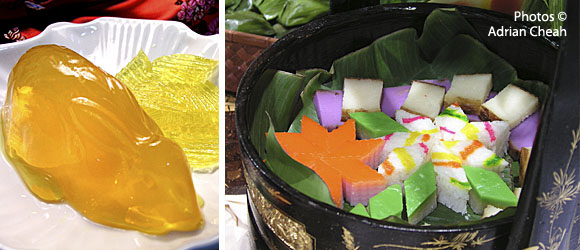
Historical records suggest that when Chinese migrants arrived in then Malaya, they brought with them several culinary styles, among them Hakka, Hainan, Foochow, Canton and others. One style of cooking which metamorphosed out of these 'prototypes' is known today as Nyonya or Chinese Peranakan cuisine, a combination of Chinese and Malay flavours.
The Chinese Peranakans
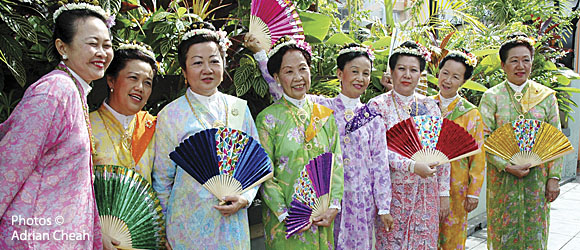
In a nutshell, the Chinese Peranakan culture is itself a melding of two distinct groups, namely the Chinese who settled in Southeast Asia in the 19th century and the local Malays.
Out of this intermixture came forth interesting customs and traditions hitherto non-existent.
Even the Malay language, used by the Nyonyas in daily communication, was given a new twist when mixed with a few Hokkien words. They spoke almost no Mandarin (the lingua franca of their ancestral homeland) and were unable to read Chinese. Their way of dressing, like the sarong, kebaya and kerongsang, was also strongly influenced by the Malays.
Chinese Peranakan cooking
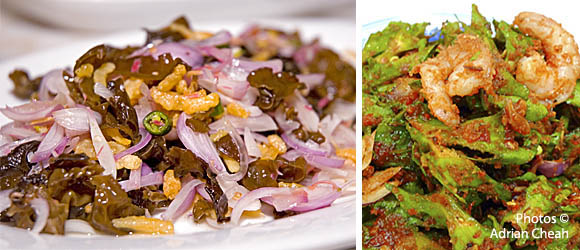
In Penang today, authentic Chinese Peranakan food is more of a home-cooked speciality than an everyday meal you would easily find in any eating outlet or hawker.
One is more often likely to find food like noodles, fish balls, dumplings and 'economy rice' rather than "genuine" Nyonya food. This is hardly surprising because the preparation and cooking of Nyonya food can be a laborious, meticulous and time-consuming affair. The grinding, blending, pounding, and marinating of the ingredients can take several hours.
The ingredients
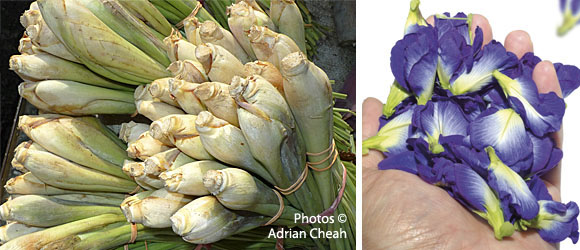
What sets Nyonya cooking apart from typical Chinese or Malay cuisines are the ingredients. Fragrant spices and herbs not usually found in Chinese cooking are used liberally. Pork, meat which is taboo for the Malays and Muslims, is commonly found in Nyonya dishes.
A key ingredient in nearly all Nyonya savoury dishes is belacan, a condiment often spoken of in the same breath as durian. Made from sun-dried shrimps compacted into rectangular cakes resembling blocks of butter, this pungent paste is as important to Peranakan cooking as curry powder is to the Indian kitchen.
Other typical Nyonya spices and condiments include lemongrass, lengkuas (galangal or wild ginger), kunyit (turmeric root), fresh or dried chillies, candlenuts, shallots, kaffir lime leaves, pandan (screwpine), daun salam (fresh bay leaves), daun kesum (Thai basil leaves), daun kunyit (turmeric leaves) and ginger buds.

Strange as it may sound, geographical location also played a major role in determining the flavour of Nyonya food in the early days. This anomaly can be savoured in Nyonya dishes found in Penang and other Northern states which have a dominantly sourish character, flavoured with tamarinds, unripe mangos, chillies and otak udang or prawn paste (a close relative of belacan, as both are made of prawns and feature pungent and sharp aromas).
Malaccan Nyonyas, on the other hand, were influenced by Indonesia, and used coconut milk liberally as a principal ingredient combined with aromatic Malay spices. It would also appear that the cuisine of Malacca's large Eurasian community had, after a while, cross-bred with that of Malacca's Nyonyas, creating new hybrids.
The presence of the colonial government added a Western touch to Peranakan cuisine. Lea & Perrins and HP shared a space with soya sauce and otak udang on the dining table and in the kitchen.
Breakfast no longer consisted of rice porridge and noodles, but included toasted bread, marmalade, scrambled and poached eggs, sausages, bacon and ham as well.
Time has a way of blurring the lines that differentiate one from the other, and when one speaks of Nyonya food these days, there's hardly any distinction between the different flavours and specialities. One could, for example, order Curry Kapitan, Inche Kabin, spring rolls, Assam Pedas, Laksa or Sago Pudding with gula Melaka sauce in any Nyonya restaurant in Malaysia.
Typical Nyonya savoury dishes include: Otak-otak, Ayam Pongteh, Devil's Curry, Tauyu Bak, Pai Tee, Assam Pedas, Curry Kapitan, Inche Kabin, Roti Babi, Babi Chin, Kangkung Belacan, Assam Laksa, Laksa Lemak, Ayam Buah Keluak Masak Assam, Geram Asam and Itik Tim.
Chinese Peranakan kitchen and dining utensils

We may not realise it, but it's very important that the correct type of utensils and stoves are used for the type of food that is cooked. Because the cooking style of the Nyonya and Malay is somewhat similar, it follows that the utensils used will also be quite the same. These include lesung batu (pestle and mortar), batu giling (stone rolling pin and flat granite bed) and the batu boh (mill) which are used to pound and grind chillies, onions, belacan, dried shrimps and spices; moulds for kuih bahulu (a type of sponge cake) and kuih kapit (love letters); coconut scraper, kuali for frying and charcoal stoves.
These days, however, the electric cuisinette, blender and gas cooker have taken the place of the manual pounding and hot smoky stove.
While the simple Peranakan family of old may tuck into a meal using their hands, food was always served on exquisite Chine blue porcelain plates, bowls, spoons, sauce dips and gold-tipped ivory chopsticks in wealthy Peranakan homes. Teacups were inscribed with gentle greetings like Slamat Minoem (drink safely), Slamat Makan (eat safely) and Umor Panjang (longevity). Similar greetings were also inscribed on tiffin carriers.
Tiffin carriers, also known as mangkok tengkats (literally multi-tiered bowls), were used by Nyonyas to transport food. The four-layered one shown in the picture (right) is made of pink porcelain and looks pretty enough to serve on the dining table. It has to be supported by two pieces of circular boards on the top and bottom, three wooden sticks and a brass handle before it can be moved. Later tiffin carriers were made of enamel and came with the handle built-in.
Food presented as gifts to friends were packed in multi-tiered rattan baskets coloured red, black and gold. Authentic versions of these items that are still in good condition are sold as high-priced antiques. Although China has been mass-producing faux Nyonya ware like the baskets and blue and white porcelains, the original pieces are still prized by collectors.
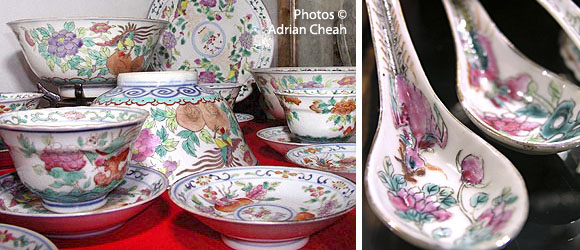
The main difference between the two is the manufacturing process and the materials used. While the genuine ware features hand-painted designs on thin and delicate porcelain, the modern versions are more robust with stamped designs.
Any leftovers were kept in a 'meat safe' – a wooden cupboard with fly-screen doors, left on a table and covered with a tudung saji (conical cover lined with attap leaves to keep food from insects) or kept in a small wooden airy cupboard hung from the ceiling like a birdcage.
To sample some of the best Nyonya dishes in town, try these restaurants:

- Auntie Gaik Lean’s: 1, Bishop St | T: +604 263 8121
- Little Nyonya Kitchens: 179, Lebuh Noordin | T: +604 261 6731
- Ivy's Kitchen: 58, Jalan Chow Thye | T: +6013 433 7878
- Kebaya Dining Room: Seven Terraces, Lorong Stewart | T: +604 264 2333
- Mama's Nyonya Cuisine: 31-D, Lorong Abu Siti | T: +604 229 1318
- McNair Restaurant Nyonya Cuisine: 164,166, 168 Lebuh Mcnair | T:+604 261 0096
- Mrs Breeze Desire: 3A-1-7, Straits Quay | T: +604 899 9058
- Nyonya Su Pei Private Dining: No 2, Bodhi Highway | T: +6016 410 6116
- Perut Rumah Nyonya Cafe: 17, Jalan Bawasah | T: +604 227 9917
- Richard Rivalee Nyonya Restaurant: 79-G-45 , Ivory Tower (M Mall) | T: +6011 1649 6399
- The Legend Nyonya House: 2, Gat Lebuh Chulia | T: +604 251 9598
---------------------------------------------------------
Written and photographed by Adrian Cheah
© All rights reserved
Updated: 23 March 2019